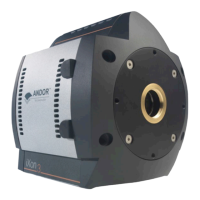Page 20
Features & Functionality
During an acquisition using a conventional Frame Transfer CCD (FT CCD), the image area is exposed to light and an
image is captured. This image in the form of an electronic charge is then automatically shifted downwards behind the
masked region of the chip before being read out. To read out the sensor, charge is moved vertically into the readout
register, and then horizontally from the readout register into the output node of the amplier. As stated on the previous
page, the readout register is extended to include the multiplication (gain) register. The amplication occurs in this
register through the scheme highlighted below in gure 12 below. When moving charge through a register there is a very
tinybutniteprobabilitythatthechargesbeingtransferredcancreateadditionalchargebyaprocessknownas“impact
ionization”.Impactionizationoccurswhenachargehassufcientenergytocreateanotherelectron-holepairandhence
a free electron charge in the conduction band can create another charge. Hence, amplication occurs. To make this
process viable, EMCCD’s tailor the process in two ways, as follows:
1. Firstly, the probability of any one charge creating a secondary electron is increased by giving the initial electron
charge more energy. This is typically done by replacing one of the electrodes (phases) of this readout section with
two electrodes. The rst is held at a xed potential and the second is operated as normal, except that much higher
voltages are employed than are necessary for charge transfer alone. The large electric eld generated between the
xedvoltageelectrodeandtheclockedelectrodeissufcientlyhighfortheelectronstocause“impactionization”as
they transfer. The impact ionization causes the generation of new electrons, i.e. multiplication or gain.
2. Secondly, the EMCCD is designed with hundreds of cells or pixels in which impact ionization can occur and
although the probability of amplication or multiplication in any one pixel is small (only around x1.01 to x1.015 times)
over the entire length of the EM register the probability is very high and substantial gains of up to thousands can be
achieved.
Figure 12: Gain register operation

